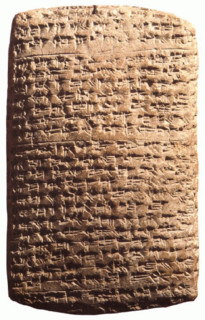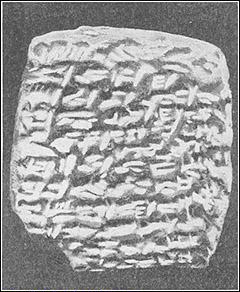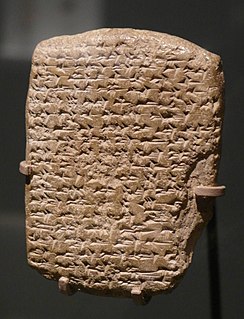DU–Teššup was the son of Aziru, of the 1350–1335 BC Amarna letters correspondence, and also the father of Aziru's successor, in Amurru. DU-Teššup's name refers to the Hurrian god of sky and storm, Teshub.
Tutu was one of pharaoh's officials during the Amarna letters period 1350–1335 BC. He is only found in the body of letters from Aziru, and his son, DU-Teššup. Four of the Amarna letters—EA 158, 164, 167 and 169—are addressed to the Pharaoh, by way of Tutu. DU-Teššup's single letter is written to pharaoh because his father Aziru is being detained in Egypt, and Aziru is needed to attend to affairs at home. Unless he were to remarry he may never return home again.
Niya, Niye, and also Niy of Thutmose I's Ancient Egypt, also Nii of the Amarna letters, and Nihe, etc. was a kingdom in Syria, or northern Syria.

Pawura, and also: Pauru, Piwure, Puuru/Puwuru was an Egyptian official of the 1350–1335 BC Amarna letters correspondence. As mentioned in letter no. 171, he was also an Egyptian "archer–commander". In letter no. 289 he is called an "irpi–official". In Egyptian his name means 'the Great One', (Pa-wr/Pa-ur)(letter EA 287:45-"1.-Pa-Ú-Ru")

Tunip was a city-state in western Syria in 1350–1335 BC, the period of the Amarna letters. The name "Syria" did not yet exist, though this was already the time of ancient Assyria. The regions were: Amurru, Nuhašše, the Amqu, Nii, etc.
Abimilki around 1347 BC held the rank of Prince of Tyre, during the period of the Amarna letters correspondence. He is the author of ten letters to the Egyptian pharaoh, EA 146–155. In letter EA 147, Pharaoh Akhenaten confirmed him as ruler of Tyre upon the death of his father, and in EA 149, referred to him with the rank of rabisu (general).

Amarna letter EA 19 is a tall clay tablet letter of 13 paragraphs, in relatively pristine condition, with some minor flaws on the clay, but a complete enough story that some included words can complete the story of the letter. Entitled "Love and Gold", the letter is about gold from Egypt, love between father-king ancestors and the current relationship between the King of Mitanni and the Pharaoh of Misri (Egypt), and marriage of women from King Tushratta of Mitanni to the Pharaoh of Egypt.

Amarna letter EA 161, titled An Absence Explained, is a tall clay tablet letter of 8 paragraphs, with single paragraphing lines. The surface is somewhat degraded, but most cuneiform signs that remain, allow for a relative complete translation context for the letter, and the eight paragraphs. The clay tablet is no. BM 29818 at the British Museum; the number is visible at the top of the tablet, above Para I-(in black ink, the top half of the number visible).

Amarna letter EA 282 is a relatively short ovate clay tablet Amarna letter, located in the British Museum, no. 29851.

Amarna letter EA 365, titled Furnishing Corvée Workers, is a squarish, mostly flat clay tablet, but thick enough (pillow-shaped), to contain text that continues toward the right margin, the right side of the obverse side, and also to the right side of the reverse side of the tablet.

Amarna letter EA 364, titled Justified War, is a clay tablet letter from Ayyab, ruler of Aštartu, to Pharaoh Akhenaten.

Amarna letter EA 287, titled: "A Very Serious Crime," is a tall, finely-inscribed clay tablet letter, approximately 8 in tall, from Abdi-Heba the mayor/ruler of Jerusalem, of the mid 14th century BC Amarna letters. The scribe of his six letters to Egypt were penned by the "Jerusalem scribe"; EA 287 is a moderately long, and involved letter. The Amarna letters, about 300, numbered up to EA 382, are a mid 14th century BC, about 1350 BC and 20–25 years later, correspondence. The initial corpus of letters were found at Akhenaten's city Akhetaten, in the floor of the Bureau of Correspondence of Pharaoh; others were later found, adding to the body of letters.

Amarna letter EA 325, titled: "Preparations Completed (2)," is a shorter-length clay tablet Amarna letter from Yidya the governor-'mayor' of Ašqaluna-(Ashkelon). It is a letter addressing the Pharaoh in high terms, as well as stating the 'governor of Ašqaluna' is making preparations for the arrival of the Pharaoh's archer-army, the archers. EA 325 is a vassal-state letter, and has some similar appearances, for example appearing like letters EA 270 and EA 271.

Amarna letter EA 100, titled: "The City of Irqata to the King" is a short-, to moderate-length clay tablet Amarna letter from the city-state of Irqata,, written to the Pharaoh of Egypt. Only one other city sent a clay tablet Amarna letter to the Pharaoh, namely Tunip, letter EA 59, titled: "From the Citizens of Tunip".

Amarna letter EA 323, titled: A Royal Order for Glass, is a smaller, square, mostly flat clay tablet letter written on both sides, but only half of the reverse; it is also written on the bottom, and is a letter from 'governor' Yidya, and is a short letter like many of his other Amarna letters, numbered EA 320 to EA 326.

Amarna letter EA 149, titled: "Neither Water nor Wood" is a moderate- to extended-length clay tablet Amarna letter from Abimilku of Tyre-(called Ṣurru in the letters), written to the Pharaoh of Egypt.

Amarna letter EA 156, titled: "Aziru of Amurru", is a very short letter from Aziru, the leader of the region of Amurru. EA 156 is the first letter in a series of 16 letters regarding Aziru.

Amarna letter EA 158, titled: "Father and Son", is a moderate length letter from Aziru, the leader of the region of Amurru. The letter is written to the Egyptian official, Tutu/ (Dudu). EA 158 is the third letter in a series of 16 letters regarding Aziru.

Amarna letter EA 170, titled: "To Aziru in Egypt", is a moderate length letter, from Aziru, the leader of the region of Amurru. EA 170 is the fifteenth letter in a series of 16 letters regarding Aziru.

Amarna letter EA 147, titled A Hymn to the Pharaoh, is a moderate length clay tablet Amarna letter from Abimilku of Tyre-(called Ṣurru in the Abimilku letters, and an island, until the time of Alexander the Great, 330 BC). The letter is a twin letter to EA 149, which is identical in length, and complexity, and EA 147 appears to precede EA 149.










